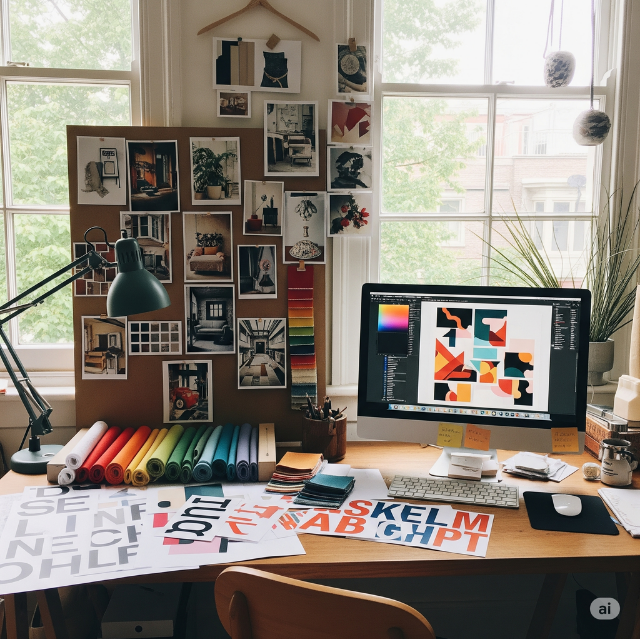How to Discover and Develop Your Unique Design Style
Design isn’t just about following trends or mimicking what others are doing. It’s about finding a visual voice that’s uniquely yours — a style that reflects your personality, your point of view, and your creative instincts.
If you’ve ever asked yourself, “How do I find my design style?” — you’re not alone. The good news? Your style already exists. You just need to uncover, shape, and own it.
Why Having Your Own Style Matters
A personal design style helps you:
- Stand out in a crowded creative world
- Build recognition and trust
- Feel more confident in your choices Attract clients who resonate with your vibe
Think of it like a visual fingerprint — no one else can duplicate it, but it takes time to define.
1. Look at Your Own Work First
Start by reviewing everything you’ve created — even school projects or past client work.
Ask yourself:
- Which projects felt most like “you”?
- What colors, layouts, or moods do you keep coming back to?
- Which designs made you think “this just clicks”?
You’re looking for patterns — the hidden DNA of your style. Write them down. It could be a color scheme, a love for asymmetry, or even playful type.
2. Collect What Inspires You (But Don’t Copy)
Inspiration is fuel, but copying is creative quicksand.
Start a:
- Mood board on Pinterest or Notion
- Screenshot folder of favorite designs
- Notebook for ideas, themes, and styles that spark something
Look beyond design too — fashion, photography, nature, architecture. Often your style is shaped by things you feel, not just what you see.
3. Experiment with Mediums and Techniques
Your style won’t emerge by doing the same thing over and over.
Try:
- Different software (Illustrator vs. Figma)
- Physical art (sketching, collage)
- Unexpected color palettes
- Layouts you don’t usually try
Push yourself. Break your own habits. Each experiment brings you closer to what feels authentically yours.
4. Create Personal Projects
Some of the best style breakthroughs happen outside client work.
Why?
- No limits
- No briefs
- No pressure to please anyone else
Examples:
- Redesign your favorite album cover
- Make fake branding for a coffee shop
- Reimagine a popular website in your own aesthetic
Treat them like a playground, not a test.
5. Document Your Style
Once you start noticing what works and what repeats — write it down. Create your own mini style guide.
Include:
- Go-to colors
- Fonts you love
- Shapes, spacing, layout preferences
- Imagery rules (bold photos, minimal icons, etc.)
This isn’t forever — your style will evolve. But documenting it gives you a solid visual foundation.
6. Stay Open to Change
Your style will shift over time — and that’s a good thing.
New tools, new influences, or even life changes (yes, even moving cities!) can affect how you design.
Revisit your old work every few months. See how far you’ve come. Let your style grow with you.
7. Study Other Designers — and Learn from Them
Look at the portfolios of designers you admire.
Ask:
- What makes their work feel cohesive?
- How do they use color, type, and space?
- What emotional tone do their designs carry?
You’re not copying — you’re reverse-engineering. Seeing how others built a visual identity helps you build your own.
8. Identify Your Design “Voice”
Think beyond the visuals.
What does your style say?
Are you:
- Friendly and playful?
- Bold and futuristic?
- Elegant and calm?
Align your design voice with your personality. The more aligned it is, the more natural and confident your work will feel.
9. Avoid These Common Mistakes
- Copying trends too closely
It’s okay to borrow ideas, but don’t lose your voice in the noise.
- Waiting for your style to be perfect
It won’t be. Ever. Keep creating and evolving.
- Thinking you need to “pick one style and stick to it forever”
Designers evolve — and so will your style.
10. Practice Consistency in Your Work
To strengthen your style, use it consistently:
- In your portfolio
- On social media
- In freelance projects (when appropriate)
The more you repeat certain choices, the more your style becomes recognizable.
💡 Tip: Use a template or layout system that aligns with your aesthetic to build consistency faster.
11. Create a “Style Library” for Yourself
This is like your own creative toolbox. It can include:
- Color palettes that feel like “you”
- Favorite font pairings
- UI components or shapes you love
- Grid or layout structures you reuse
Having this reference keeps your design workflow fast and authentic.
12. Design Daily — Even Just a Little
Consistency builds clarity.
Try a:
- 30-day poster challenge
- Daily UI prompt
- Weekly brand concept
The more you create, the more your instincts sharpen — and that’s where style comes from.
Checklist: Are You Developing a Personal Style?
✅ I see recurring visual choices in my work
✅ I can explain why I choose certain colors/fonts/layouts
✅ My portfolio feels cohesive, not random
✅ I’ve created personal projects that reflect my taste
✅ My style feels like an extension of my personality
✔️ 3+ checkmarks? You’re on the right track.
Final Thoughts: Your Style Is Your Superpower
Here’s the truth: your design style already exists. It’s in your preferences, your mistakes, your mood boards, your voice.
You don’t have to chase trends or wait for permission. You just have to show up, explore, and create — over and over again.
In time, your style will reveal itself. And when it does, it’ll feel effortless — because it’s not a trend. It’s you.
From zero to design hero — keep creating!
by Cris.

